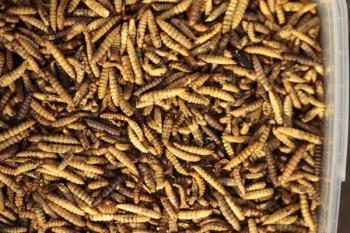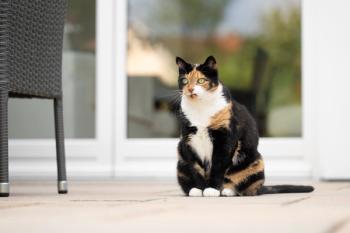
Obesity (Proceedings)
Obesity is the excessive accumulation of adipose tissue (FAT). It occurs due to an imbalance of energy intake versus energy expenditure.
Obesity is the excessive accumulation of adipose tissue (FAT). It occurs due to an imbalance of energy intake versus energy expenditure. In general pets are defined as overweight when their body weight is 15% over their optimal body weight. They are obese when they are 30% over their optimum. Five extra pounds on a cat is equal to about 44 pounds on a human being! Using these criteria, the prevalence of obesity in dogs and cats in the United States has reached epidemic proportions, between 30% and 40%. Unfortunately there is evidence that the incidence of obesity is increasing despite many tools and programs for diet and exercise to control weight today.
Historically, the functions of fat have been understood as energy storage, thermal insulation, and structural support for internal organs. It is now known that fat is metabolically active and is therefore the largest endocrine organ in the body. The primary reason for development of obesity is that they are consuming more energy than they are expending. This can occur when an animal has excessive dietary intake of calories (all food and treats) or when there is a decrease in energy expenditure (illness or injury). There are some medical conditions (hypothyroidism, etc.) and medications (steroids, etc.) that contribute to obesity.
There are a number of problems found in obese animals compared to ideal body weight animals such as increased anesthetic risk, heat intolerance, orthopedic diseases, diabetes mellitus, heart disease, certain cancers, urethral incompetence and lower urinary tract disease, dyspnea, dystocia, prolonged surgical procedures and increased difficulty with palpation, catheter placement and imaging. As of yet we do not have a complete understanding of the inflammatory role of obesity hormones in out pets, which could lead to a greater connection between obesity and disease.
Genetics can play a role although it needs further investigation. We know specific dog breeds are likely to become over weight such as, golden retrievers, cocker spaniels, dachshunds, Labrador retrievers, Rottweilers and Dalmatians. In cats most mixed breeds (DSH, DLH, etc) and Manx cats were more likely to be obese that most purebred cats.
In both dogs and cats, neutering is an important trigger. Neutered dogs are about twice as likely to be overweight than intact dogs. The hormonal changes that occur post-neuter result in increased appetite but decreased energy metabolism and metabolic rate by about 25%. The majority of animals are neutered when they are growing from juveniles to adults. Also, the pet food nutritional statement reported on food labels is for intact dogs and cats, not neutered dogs and cats. The key is to prevent weight gain during this time period, as it is much harder to lose weight that to prevent weight gain. Following neutering it is recommended to decrease caloric intake by 25% and discontinue free-choice feeding.
Food choices and method of feeding influence weight. Today there are a plethora of highly palatable foods and treats available on the market. Despite rising unemployment, credit-card debt and less discretionary spending, American pet owners remain loyal to their animals (and the industry). According to the American Pet Products Association retail sales of pet food were up 4.5% in 2009 at about $18 billion with projected sales to top $21 billion by 2013! Dogs that are allowed to be near their owners at mealtime had a greater tendency to be obese due to the increased likelihood of receiving table scraps. This feeding interaction can become a social problem resulting in over feeding and inappropriate behavior. It has been shown that dogs living in households with health-conscious owners tend not to be obese.
Dogs and cats are subject to the same detrimental affects of obesity as humans with the end result being premature death and earlier onset of obesity-related diseases such as diabetes mellitus, osteoarthritis and some cancers. In a recent study of canine diet and health, dietary calorie restriction was clearly shown to increase longevity in a group of paired sibling Labrador retrievers. The lean-fed dogs were fed 25% less food than their littermate starting at eight weeks of age. The lean-fed dogs lived on average two years longer and had reduced incidence of hip dysplasia, osteoarthritis, and diabetes mellitus.
Reduced activity is a risk factor for obesity in cats and dogs, as well as age. In metropolitan areas apartment dwellers are suggested to be overweight.
Traditionally the veterinary profession used actual body weight as the assessment. While that is important, assessment. In 1997 a novel system was devised to estimate body condition score (BCS) of animals. It is an assessment of the animal's weight and its relative proportions of muscle and fat. The assessment is made visually on the basis of amount of soft tissue cover over the body. Areas most noted are hips, abdomen/caudal abdomen and ribs. Each animal is graded by comparison with a standardized chart on a scale of one to nine.
Scoring BCS is extremely easy, fast and inexpensive, yet overlooked many times. The animal is too thin if you can see and palpate ribs, vertebrae and pelvic bones. These are categorized as a 1-3/9. Too heavy is when you can't see or feel the ribs or vertebrae and the waist has disappeared with massive fat overlying the body. These are categorized as 6-9/9. The ideal BCS is a 4/9 or a 5/9. These animals have ribs that are easily palpable, an easily noted waist and having an abdominal tuck. This scoring system is easy to teach the clients and preferred in lieu of weight assessment in pounds/kilograms, especially as home personal scales are difficult to use with large dogs.
Many pet owners, when asked to assess the BCS of their pet, incorrectly assess their pet as normal, even when shown a visual chart. The problem is more prominent in overweight pets as it has been determined that only one out of seven owners of overweight pets correctly recognize their pet as overweight. It is very important to honestly and openly discuss the pet's weight at each visit.
After discussions with the owner addressing their animal's physical condition of obesity, it is important to formulate a tailored dietary therapy regime restricting calories without protein starvation. The reason is two-fold; protein increases satiety and prevents lean muscle tissue loss. It is very important to discuss expected goal and the timeline. If the cat took a year to get fat, then it may take that long to get better. If the timeline is incorrect many owners become disillusioned and quit the diet prematurely. It is very important to set realistic goals rather than overly ambitious goals. According to some, the best way to restrict calories is to reduce them intake by 60-80% of the pet's current intake. Alternatively you can calculate the energy in the amount of fat mass you wish the pet to lose. One pound of fat is 3600 calories. Take this number and divide by the number of days you plan to feed the weight reduction diet. There are other approaches as well however the key point is to set a target calorie intake, weigh the animal monthly, and adjust the amount of food based on weight loss. Decreases should not be implemented more often than every three to four weeks to allow for metabolic adjustment. Nutritionists argue that feeding a restricted-calorie diet does not provide a complete and balanced diet, however there is no long-term damage associated with temporarily feeding this way. It is important to note that animals should not lose more than one to two percent of its body weight per week.
A special note on cats here. They are not small dogs. There has been MUCH debate over cats and carbohydrates in the recent past. Cats are obligate carnivores and therefore utilize protein as their energy source. Any carbohydrates in the diet that are not immediately used for energy will be stored as fat. Thus indoor or sedentary cats being fed typical dry diets (usually high carbohydrates) are often consuming many more calories from carbohydrates than they will burn. Remember in low energy states, cats will use protein for energy and so even if they are not consuming very much, they will gain weight. Several recent studies have shown that use of a high-protein, low carbohydrate diet will reduce body fat while preserving lean body mass. Currently the best commercial diets for cats needing to lose weight are generally canned foods as usually all dry foods have more carbohydrates. If a new diet is introduced cats should be monitored for anorexia and the risk of developing hepatic lipidosis.
Exercise is very important in both species. Walking is excellent as a low-impact exercise and a way to lubricate all joints. It is especially good for all dogs predisposed to intervertebral disk disease. In suburban setting with fenced in yards when owners are asked about daily activity they respond with "she is out side all day" but what they really mean is "she slept on the porch, basking in the sunlight all day". It is helpful to keep track of amount of exercise the animal is getting. When enrolling an overweight pet in an exercise program it is important to start slowly with low-impact exercise. Many of these animals have stressed their joint with extra weight and are predisposed to injury if not careful. Currently on the market are 'joint diets' but they are not formulated to be weight loss diets therefore careful caloric evaluation is required.
Getting cats to exercise may be an oxymoron however environmental enrichment can play a role. Food puzzle balls are a great way to encourage energy expenditure. Many owners assume when cats approach them it is for food, but any type of attention can be given (brushing if they enjoy it, massage, cat nip laser pointes, etc.). When implementing play activity it is best to start with a few short (under three minute) sessions each day. Feline play stations are good for exercise and incorporate the ability to climb, scratch and balance.
In addition to traditional therapies there are newer pharmacological approaches. These drugs enhance fat excretion, reduce appetite and increase metabolism. They are only approved for dogs and must be used under the direct supervision of a veterinarian.
When embarking on a weight loss program with an owner and patient it is very important to call and check in with them. The bottom line is that prevention of obesity in dogs and cats can increase both the quality and quantity of their life.
New research
Linder D, Freeman L. Evaluation of calorie density and feeding directions for commercially available diets designed for weight loss in dogs and cats. J Am Vet Med Assoc. 2010; 236(1): 74-77.
Obesity is a very common health problem in dogs and cats, with 22-44% of the US population currently overweight or obese. This study aimed to determine the range of calorie density and feeding directions for commercially available diets and had weight management claim with feeding directions for weight loss or implied weight management claims. More than half of all foods in the study had a caloric density greater than the Association of American Feed Control Officials (AAFCO) maximum caloric density for light diets. This would make successfully attaining weight loss difficult!! Weight loss requires lifestyle changes such as an increase in physical activity.
References available on request
Newsletter
From exam room tips to practice management insights, get trusted veterinary news delivered straight to your inbox—subscribe to dvm360.






